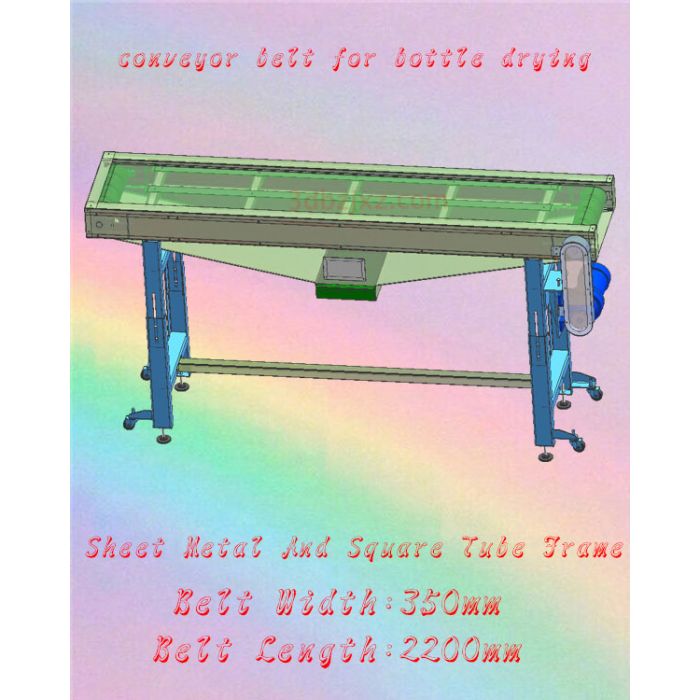beltconveyor_w350_l2200
- Stp samples download
- click to down
试用数据点击上方下载!
When designing a conveyor belt for bottle drying, multiple factors need to be considered to ensure its efficient, safe, and stable operation. Here are some key design points:
1、 Selection of conveyor belt type
Applicability: For the application scenario of bottle drying, it is necessary to choose a conveyor belt type that can smoothly transport and cause minimal damage to the bottles. Common options include belt conveyors and drum conveyors, both of which can provide stable conveying effects.
Material: The material of the conveyor belt should have certain wear resistance and corrosion resistance to cope with the friction and chemical substances that may occur during the bottle drying process.
2、 Layout Design
Space layout: Based on the spatial layout of the production line, plan the direction and length of the conveyor belt reasonably to ensure that bottles can be smoothly transported from one end of the conveyor belt to the other, and complete the drying process.
Turning radius: In order to reduce collisions and damage to bottles during transportation, the turning radius of the conveyor belt should be increased as much as possible, or buffer zones or turning rollers should be installed at the turning points.
High consistency: Maintain consistency in the height of the conveyor belt to avoid bottles collapsing or slipping due to height changes during transportation.
3、 Design of drying device
Drying method: Choose the appropriate drying method based on the shape of the bottle and drying requirements. Common drying methods include hot air drying and cold air drying. Hot air drying can quickly evaporate the moisture inside the bottle, while cold air drying helps the bottle cool down quickly.
Drying position: Set the drying device at an appropriate position on the conveyor belt to ensure that the bottles can be fully dried during the conveying process. At the same time, the design of the drying device should consider the stability and safety of the bottles to avoid them falling or being damaged during the drying process.
4、 Protection and detection devices
Protective device: Install protective covers, baffles, and other protective devices at the inlet and outlet of the conveyor belt and key positions to reduce collisions and damage to bottles during transportation.
Detection device: Install a detection device on the conveyor belt to detect and identify the status of the bottles. Once bottle abnormalities or blockages are detected, immediately issue an alarm and shut down for processing to ensure the safe operation of the production line.
5、 Safety measures and maintenance
Safety measures: Provide safety training and establish operating standards for operators to ensure they can comply with safety regulations during the operation process. At the same time, emergency shutdown devices and alarm devices should be installed to promptly shut down and issue alarms in case of emergency.
Maintenance: Regularly clean, lubricate, tighten, and inspect the conveyor belt to ensure its normal operation. At the same time, timely replacement of conveyor belts and related components based on wear and tear can extend the service life of the equipment and reduce maintenance costs.
In summary, designing a conveyor belt for bottle drying requires comprehensive consideration of multiple factors, including belt type selection, layout design, drying device design, protective and detection devices, as well as safety measures and maintenance. Through reasonable design and planning, it can be ensured that the conveyor belt plays an efficient, safe, and stable role in the bottle drying process.
在设计用于瓶子吹干的输送带时,需要考虑多个因素以确保其高效、安全和稳定地运行。以下是一些关键的设计要点:
一、输送带类型选择
- 适用性:对于瓶子吹干这一应用场景,需要选择能够平稳输送且对瓶子损伤较小的输送带类型。常见的选择包括带式输送机和滚筒输送机,它们都能提供稳定的输送效果。
- 材质:输送带的材质应具有一定的耐磨性和抗腐蚀性,以应对瓶子吹干过程中可能产生的摩擦和化学物质。
二、布局设计
- 空间布局:根据生产线的空间布局,合理规划输送带的走向和长度,确保瓶子能够顺利从输送带的一端输送到另一端,并完成吹干过程。
- 转弯半径:为了减少瓶子在输送过程中的碰撞和损坏,应尽可能增大输送带的转弯半径,或在转弯处加装缓冲区或转弯滚轮。
- 高度一致性:保持输送带高度的一致性,避免瓶子在输送过程中因高度变化而倒塌或滑落。
三、吹干装置设计
- 吹干方式:根据瓶子的形状和吹干要求,选择合适的吹干方式。常见的吹干方式包括热风烘干和冷风烘干,其中热风烘干能够快速蒸发瓶子内的水分,而冷风烘干则有助于瓶子快速冷却。
- 吹干位置:将吹干装置设置在输送带的适当位置,确保瓶子在输送过程中能够充分接受吹干处理。同时,吹干装置的设计应考虑瓶子的稳定性和安全性,避免瓶子在吹干过程中掉落或损坏。
四、保护装置与检测装置
- 保护装置:在输送带的进出口处及关键位置设置防护罩、挡板等保护装置,以减少瓶子在输送过程中的碰撞和损坏。
- 检测装置:在输送带上设置检测装置,对瓶子的状态进行检测和识别。一旦发现瓶子异常或堵塞情况,立即发出警报并停机处理,以确保生产线的安全运行。
五、安全措施与维护保养
- 安全措施:对操作人员进行安全培训和操作规范的制定,确保他们在操作过程中能够遵守安全规定。同时,设置紧急停机装置和报警装置,以便在紧急情况下及时停机并发出警报。
- 维护保养:定期对输送带进行清洁、润滑、紧固和检查,以确保其正常运行。同时,根据磨损情况及时更换输送带和相关部件,以延长设备的使用寿命和降低维护成本。
综上所述,设计用于瓶子吹干的输送带需要综合考虑多个因素,包括输送带类型选择、布局设计、吹干装置设计、保护装置与检测装置以及安全措施与维护保养等。通过合理的设计和规划,可以确保输送带在瓶子吹干过程中发挥高效、安全和稳定的作用。

